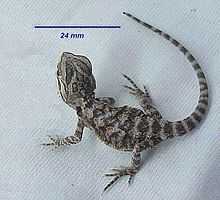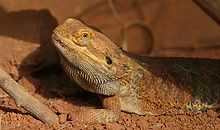Central bearded dragon
| Pogona vitticeps | |
|---|---|
 | |
| Conservation status | |
| Not evaluated (IUCN 3.1) | |
| Scientific classification | |
| Kingdom: | Animalia |
| Phylum: | Chordata |
| Class: | Reptilia |
| Order: | Squamata |
| Family: | Agamidae |
| Genus: | Pogona |
| Species: | P. vitticeps |
| Binomial name | |
| Pogona vitticeps Ahl, 1927 | |

Pogona vitticeps, the central (or inland) bearded dragon, is a species of agamid lizard occurring in a wide range of arid to semiarid regions of Australia. This species is very popularly kept as a pet and exhibited in zoos.
Description

Adults of this species can reach a total length of up to 2 ft (61 cm), with the tail accounting for more than half. Sexes are not strongly dimorphic, but males can be distinguished from females, as males have a wider cloacal opening, the base of the tail is wider, the head is usually larger with a larger beard (often black) and possess hemipenes.[1] Males also have more pronounced femoral pores than females (these can be seen as waxy bumps on the underside of the back legs).[2] Bearded dragons vary widely in colour, including brown, grey, reddish-brown, red, yellow, white, and orange. They are capable of undergoing moderate changes in the shade of their colour to help regulate temperature. The specialized scales along both sides of the throat, neck, and head form many narrow spines which run down the side of the body to the tail. When feeling threatened, a bearded dragon will flatten its body against the ground, puff out its spiny throat and open its jaws to make itself appear larger. The bearded dragon is so named because of the pouch-like projection (also called the guttural pouch) on the underside of the neck and chin area which typically turns darker than the rest of the body. It also boasts spiny projections. Both of these characteristics appear similar to a human's beard. Males typically have a darker "beard" than females, and during mating season and courtship it will typically darken to near-black. The bearded dragon, like most agamid lizards, has strong legs which enable it to lift its body completely off the ground while it moves. This is done to reduce the heat taken in from the ground, as well as to increase the air flow over the belly to cool itself further.
Pogona vitticeps was first described by Ernst Ahl in 1926, who placed it in the genus Amphibolurus.[3][4]
A studied conducted in 2014 established the existance of endogenous circadian rhythm in pigmentation changes in Pogona vitticeps. In other words, light and dark can influence the color changes of this kind of lizards. If exposed to light, the dorsal skin of the lizard becomes darker, and if exposed to darkness, it becomes lighter. Under constant darkness (i.e. in the subjective night), the lizards’ dorsal skin becomes the lightest.[5]
Ecology and behaviour

This dragon is native to the semiarid woodland, arid woodland, and rocky desert regions of Central Australia. They are skilled climbers, and often spend just as much time perching on tree limbs, fenceposts, and in bushes as they do on the ground. They spend the morning and early evening sunning themselves on exposed branches or rocks, and retreat to shady areas or underground burrows during the hottest parts of the afternoon.
Bearded dragons do not vocalize, except to hiss softly when threatened. Instead, they communicate through colour displays, posture, and physical gestures, such as leg waving and head bobbing. Bearded dragons are not social animals, but will sometimes gather in groups, especially in popular feeding or basking areas. At these times, a distinct hierarchy will emerge: the highest-ranking animals will take the best - usually the highest or sunniest - basking spots, and all other individuals arrange themselves lower down. If a low-ranking animal tries to challenge one of the dominant dragons, the dominant animal will demonstrate its superiority by bobbing its head and inflating its beard, at which point the challenger may signal submission by waving one of its forelegs in a slow circle. If the low-ranking dragon does not submit, it will return the head bob, and a stand off or fight may ensue.
The several different kinds of head bob gestures are:
- Slow bowing motion - often used by adult females to signal submission to a male
- Fast bob - used by males to signal dominance (often accompanied by an inflated and/or blackened beard)
- Violent bob - used by males just before mating, much more vigorous, and usually sets the animal's whole body in motion
- Females also do fast and violent head bobs as it shows us that they are stressed out and need some alone time. This also applies for the males.
The male will only wave to show submission to a dominant male, whereas the female will wave, followed by a slow head bob, to show she is ready to mate. Gravid females will often refuse the advances of a male by chasing him and lying on his back.
When under direct attack, the central bearded dragon opens its mouth to display its yellow membranes and extend its beard.[6] It darkens the colour of its skin and flattens its body, and will hiss and make small jumps towards the attacker. Bearded dragons are not known to attack humans.[7]
Reproduction

The age of sexual maturity has not been measured, although it is estimated to be about one or two years.[8] Body size and growth rates are more important than age when determining sexual maturity in bearded dragons.[9] Males will become very aggressive towards each other and will assert their dominance by inflating their beards and through fast head bobbing. Breeding typically occurs in the early spring. Females will lay a clutch of 11-30 oblong-shaped eggs in a shallow nest dug in the sand. After being laid, the eggs are buried and are left unattended. The eggs will hatch approximately 60 to 80 days later, depending on the incubation temperature. In captivity, they can be incubated in a styrofoam fish box, but without a male lizard, the female's eggs will not be fertile. However, a female bearded dragon can retain sperm, and thus produce fertile eggs even after being separated from a male.
Courtship involves the male "head bobbing" to display dominance. If the female displays submissive behaviour, the male will use its mouth to grab the back of the female's head and the male will also wrap its front legs around the female's upper torso to keep her from moving. Copulation and insemination are quick. The gestation period averages about a month and a half.
Captive breeding

Several of the Pogona genus are bred in captivity as pets; the two most popular are this species, P. vitticeps, and the western bearded dragon (Pogona minor minor).[10][11] The bulk of captive-bred bearded dragons today are thought to have originated from stock illegally exported from Australia during the 1970s. [12]
Captives world wide are threatened by Agamid adenovirus, a virus that compromises the immune system of the dragon, and leads to death from other diseases. However, the majority of the infections are subclinical. Subclinically infected animals show no symptoms, but are active carriers of the disease and will infect other bearded dragons.
When the female is ready to lay eggs, she will generally stop eating and spend most of her time trying to dig.
Further Reading
Kis, Anna; Huber, Ludwig; Wilkinson, Anna (January 2015). "Social learning by imitation in a reptile (Pogona vitticeps)". Animal Cognition 18 (1): 325–331. doi:10.1007/s10071-014-0803-7.
References
- ↑ Doneley, B. (2006). Caring for the bearded dragon. Proceedings of the North American Veterinary Conference (20): 1607-1611.
- ↑ "Reptile Care and Husbandry: Bearded Dragons". Reptile Specialists LLC. 2008. Archived from the original on 2012-02-19.
- ↑ Ahl,E. 1926. Neue Eidechsen und Amphibien. Zool. Anz. 67: 186-192
- ↑ Pogona vitticeps at the Reptarium.cz Reptile Database
- ↑ Fan, Marie; Stuart-Fox, Devi; Cadena, Viviana (29 October 2014). "Cyclic Colour Change in the Bearded Dragon Pogona vitticeps under Different Photoperiods". PLoS One 9 (10): Article No.: e111504. doi:10.1371/journal.pone.0111504. Retrieved 29 October 2014.
- ↑ Witten, G.J. (1993). No. 29 Family Agamidae. Fauna of Australia. Volume 2A. AGPS Canberra
- ↑ Doneley, B. (2006). Caring for the bearded dragon. Proceedings of the North American Veterinary Conference (20): 1607-1611.
- ↑ DPIPWE (2011) Pest Risk Assessment: Central bearded dragon (Pogona vitticeps). Department of Primary Industries, Parks, Water and Environment. Hobart, Tasmania.
- ↑ Doneley, B. (2006). Caring for the bearded dragon. Proceedings of the North American Veterinary Conference (20): 1607-1611.
- ↑ "Pet Profile - Bearded Dragons". The Pet Show. Australian Broadcasting Corporation. 2008.
- ↑ Browne-Cooper, Robert; Brian Bush; Brad Maryan; David Robinson (2007). Reptiles and Frogs in the Bush: Southwestern Australia. University of Western Australia Press. p. 161. ISBN 978-1-920694-74-6.
Western Bearded Dragon, Pogona minor minor
- ↑ Steve Grenard - Your Happy Healthy Pet: Bearded Dragon 2nd Edition, page 35
External links
| Wikimedia Commons has media related to Pogona vitticeps. |
| Wikispecies has information related to: Pogona vitticeps |